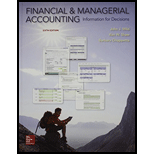
Concept explainers
Current ratio is the ratio which is used to measure a company’s liquidity and it considers current assets and current liabilities.
Acid-test Ratio:
Acid test ratio is a ratio which is measures the ability of a company to pay off its current obligations out of near cash or quick assets.
Day’s sales Uncollected:
Day’s sales uncollected imply how much days a company takes to collect its accounts receivables.
Inventory Turnover:
Frequency of a company’s inventory sold or returned is shown by inventory turnover.
Day’s sales in Inventory:
Day’s sales inventory shows the average number of days the company not selling its inventory or holding it before selling.
Debt to Equity Ratio:
Debt to equity ratio is a solvency ratio which indicates relative proportion of total liabilities and total equity.
Time Interest Earned:
Time interest earned is the ratio which reflects risk of loan repayments of vendors or creditors of with interest.
Profit Margin Ratio:
Profit margin ratio shows net income as a percent of sales. This ratio reflects a company’s ability of earning.
Total Assets Turnover Ratio:
Total assets turnover ratio is the measurement of a company’s revenue or sales to its value of total assets.
Return on Total Assets Ratio:
Measurement of a company’s earnings against its net assets is known as return on total assets ratio.
Return on Common
Return on common stockholder’s equity displays returns received on stockholder’s equity for a certain period of time.
To compute: (1) current ratio, (2) acid test ratio, (3) day’s sales uncollected, (4) inventory turnover (5) day’s sales in inventory (6) debt to equity ratio (7) time interest earned (8) profit margin ratio (9) total assets turnover ratio (10) return on total assets ratio (11) return on common stockholder’s equity of S Company.
Explanation of Solution
(1)
Given,
Current assets are $43,600.
Current liabilities are $17,400.
Formula to calculate current ratio,
Substitute $43,600 for current assets and $17,400 for current liabilities.
Working notes:
Compute the current assets:
Compute the current liabilities
Thus, current ratio is 2.51.
(2)
Given,
Cash is $6,100.
Short term investments are $6,900.
Accounts receivables are $12,100
Current liabilities are $17,400.
Formula to calculate acid test ratio,
Substitute $6,100 for cash, $6,900 for short term investments $12,100 for
Thus, acid test ratio is 1.44.
Working note:
Calculation of current liabilities,
(3)
Given,
Accounts receivable is $12,100.
Net sales are $315,500.
Formula to calculate day’s sales uncollected,
Substitute $12,100 for accounts receivable and $315,500 for net sales.
Thus, day’s sales uncollected are 14 days.
(4)
Given,
Cost of goods sold is $236,100.
Inventory in the beginning of the year is $17,400.
Inventory at the end of the year is $13,500.
Formula to calculate inventory turnover,
Substitute $236,100 for cost of goods sold and $17,400 for inventory in the beginning of the year and $13,500 at the end of the year.
Thus, inventory turnover is 15.3.
(5)
Given,
Inventory at the end of the year is $13,500.
Cost of goods sold is $236,100.
Formula to calculate day’s sales in inventory is,
Substitute $236,100 for cost of goods sold and $13,500 for inventory at the end of the year.
Thus, day’s sales inventory is 20.87 days.
(6)
Given,
Long term notes payable is $30,000.
Equity is $70,100.
Formula to calculate debt and equity ratio,
Substitute $30,000 for debt and $70,100 for equity.
Thus, debt and equity ratio is 0.43.
Working notes:
(7)
Given,
Income before interest and tax is $30,200.
Interest expense is $2,200.
Formula to calculate time interest earned ratio,
Substitute $30,200 for income before interest and tax and $2,200 for interest expense.
Thus, time interest earned ratio is 13.73.
(8)
Given,
Net income is $23,800.
Net sales are $315,500.
Formula to calculate profit margin ratio,
Substitute $23,800 for net income and $315,500 for net sales.
Thus, profit margin ratio is 7.54%.
(9)
Given,
Net sales are $315,500.
Assets in the beginning of the year are $94,900.
Assets at the end of the year are $117,500.
Formula to calculate total assets turnover ratio,
Substitute $315,500 for net sales, $94,900 for assets in the beginning of the year and $117,500 at the end of the year.
Thus, total assets turnover ratio is 2.97.
(10)
Given,
Net income is $23,800.
Assets in the beginning of the year are $94,900.
Assets at the end of the year are $117,500.
Formula to calculate return on total assets ratio,
Substitute $23,800 for net income and $94,900 for assets in the beginning of the year and $117,500 at the end of the year.
Thus, return on total assets ratio is 0.22.
(11)
Given,
Net income is $23,800.
Common stock in the beginning of the year is $35,500.
Common stock at the end of the year is $35,000.
Formula to calculate return on common stockholder’s equity,
Substitute $23,800 for net income and $35,500 for common stock in the beginning of the year and $35,000 at the end of the year.
Thus, return on common stockholder’s equity is 0.68%.
Want to see more full solutions like this?
Chapter 13 Solutions
Financial and Managerial Accounting with Connect

 AccountingAccountingISBN:9781337272094Author:WARREN, Carl S., Reeve, James M., Duchac, Jonathan E.Publisher:Cengage Learning,
AccountingAccountingISBN:9781337272094Author:WARREN, Carl S., Reeve, James M., Duchac, Jonathan E.Publisher:Cengage Learning, Accounting Information SystemsAccountingISBN:9781337619202Author:Hall, James A.Publisher:Cengage Learning,
Accounting Information SystemsAccountingISBN:9781337619202Author:Hall, James A.Publisher:Cengage Learning, Horngren's Cost Accounting: A Managerial Emphasis...AccountingISBN:9780134475585Author:Srikant M. Datar, Madhav V. RajanPublisher:PEARSON
Horngren's Cost Accounting: A Managerial Emphasis...AccountingISBN:9780134475585Author:Srikant M. Datar, Madhav V. RajanPublisher:PEARSON Intermediate AccountingAccountingISBN:9781259722660Author:J. David Spiceland, Mark W. Nelson, Wayne M ThomasPublisher:McGraw-Hill Education
Intermediate AccountingAccountingISBN:9781259722660Author:J. David Spiceland, Mark W. Nelson, Wayne M ThomasPublisher:McGraw-Hill Education Financial and Managerial AccountingAccountingISBN:9781259726705Author:John J Wild, Ken W. Shaw, Barbara Chiappetta Fundamental Accounting PrinciplesPublisher:McGraw-Hill Education
Financial and Managerial AccountingAccountingISBN:9781259726705Author:John J Wild, Ken W. Shaw, Barbara Chiappetta Fundamental Accounting PrinciplesPublisher:McGraw-Hill Education





